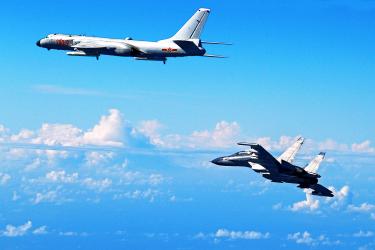Chinese military aircraft yesterday flew over the East China Sea to the south of Japan’s Okinawa Island and circled the international airspace surrounding Taiwan before passing over the Bashi Channel to return to China, officials from the Ministry of National Defense said.
It was the second time in two weeks that Chinese military aircraft have flown around Taiwan and passed over the Miyako Strait between Japan’s Okinawa and Miyako islands.
Yesterday’s flight launched at about 9am from the People’s Liberation Army (PLA) Air Force’s Eastern Theater Command bases and involved a dozen aircraft, the ministry said in a statement, adding that only four aircraft traveled the entire flight path around Taiwan.
Ministry officials did not provide any details on the type of aircraft that participated in the flight.
Two Xian H-6K bombers, a Tupolev Tu-154 surveillance aircraft and a Shaanxi Y-8 tactical transport aircraft participated in the previous flight on Nov. 25.
The aircraft taking part in yesterday’s flight were reportedly escorted by several Su-30 fighter jets coming in from the north as they crossed the Miyako Strait as per the PLA Air Force’s procedure for flying past the first island chain, before the main group turned south into international airspace.
They were similarly escorted after reaching airspace south of Taiwan as they flew over the Bashi Channel between Taiwan and the Philippines, before ending the mission and returning to their bases at 1:10pm, according to military sources.
The ministry said that the aircraft flew clockwise around Taiwan, whereas they flew counter-clockwise on Nov. 25.
"Our military forces monitored the PLA aircraft and had them under surveillance the entire time. There is no need to be concerned about the situation,” the statement read.
“After the PLA aircraft headed from the Chinese coast toward the East China Sea, Taiwan’s military radar stations locked onto them and tracked the entire flight,” said a senior military officer who declined to be named.
“The air force dispatched a reconnaissance patrol aircraft for surveillance and it took photographs of the Chinese aircraft and transmitted the images to a command station,” he said.
The ministry released the statement immediately after the incident. Following the Nov. 25 flight, the ministry’s delayed response drew criticism from the public and lawmakers, and raised concern that it had sought to cover up the incident.
Media reports said that neither flight infringed upon Taiwan’s or Japan’s territorial airspace, but this could not be independently verified.
Senior Chinese military officials in September announced that they will conduct “regular exercises” for flying past the first island chain, as China seeks to assert its presence in disputed islands and marine territories in the South and East China seas.
Taiwan has virtually identical claims in the South China Sea.
Source: Taipei Times - 2016/12/11





















